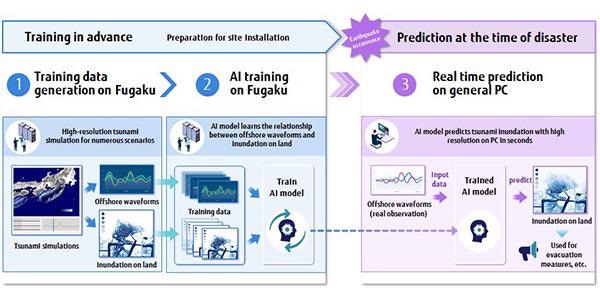Feb 16 2021
Fugaku, a new AI model leveraging the power of the world’s fastest supercomputer, can quickly forecast tsunami flooding in coastal areas before the tsunami hits the land.
 An overview of tsunami prediction with AI. Image Credit: Tohoku University, University of Tokyo, and Fujitsu Laboratories.
An overview of tsunami prediction with AI. Image Credit: Tohoku University, University of Tokyo, and Fujitsu Laboratories.
The evolution of the new technology was declared as part of a collaborative project between the International Research Institute of Disaster Science (IREDeS) at Tohoku University, the Earthquake Research Institute at the University of Tokyo, and Fujitsu Laboratories.
The 2011 Great East Japan Earthquake and the ensuing tsunami stressed the drawbacks in disaster mitigation and the need to make use of data for safe and effective evacuations.
Although tsunami observation networks in the coastal waters of Japan have been reinforced from that time, the use of data generated from those networks to forecast the path of a tsunami as soon as it reaches the land has become an emergent requirement.
This is particularly true since a huge earthquake is expected to hit the densely populated east coast region of Japan in the near future. Technologies to forecast tsunami will enable authorities to achieve precise data rapidly and help them in guiding evacuation orders efficiently.
Fujitsu, Tohoku University, and The University of Tokyo harnessed Fugaku’s power to produce training data for 20,000 feasible tsunami scenarios using high resolution simulations.
Such scenarios were employed to simplify an AI model that makes use of offshore waveform data produced by the tsunami to forecast flooding prior to landfall at high spatial resolution.
Traditional prediction technologies would need the help of supercomputers and make quick forecast systems hard to implement, but the new AI model can be made to run within seconds on normal PCs.
The model was used for a tsunami flooding simulation in Tokyo Bay subsequent to a huge earthquake, and it achieved highly precise forecasts with a normal PC within seconds. The findings corresponded with tsunami flooding of the tsunami source models issued by the Cabinet Office of Japan
The researchers will continuously use Fugaku’s high-speed performance in the future by training the system with more tsunami scenarios. This approach will help understand that AI can forecast tsunami flooding even over broader areas.